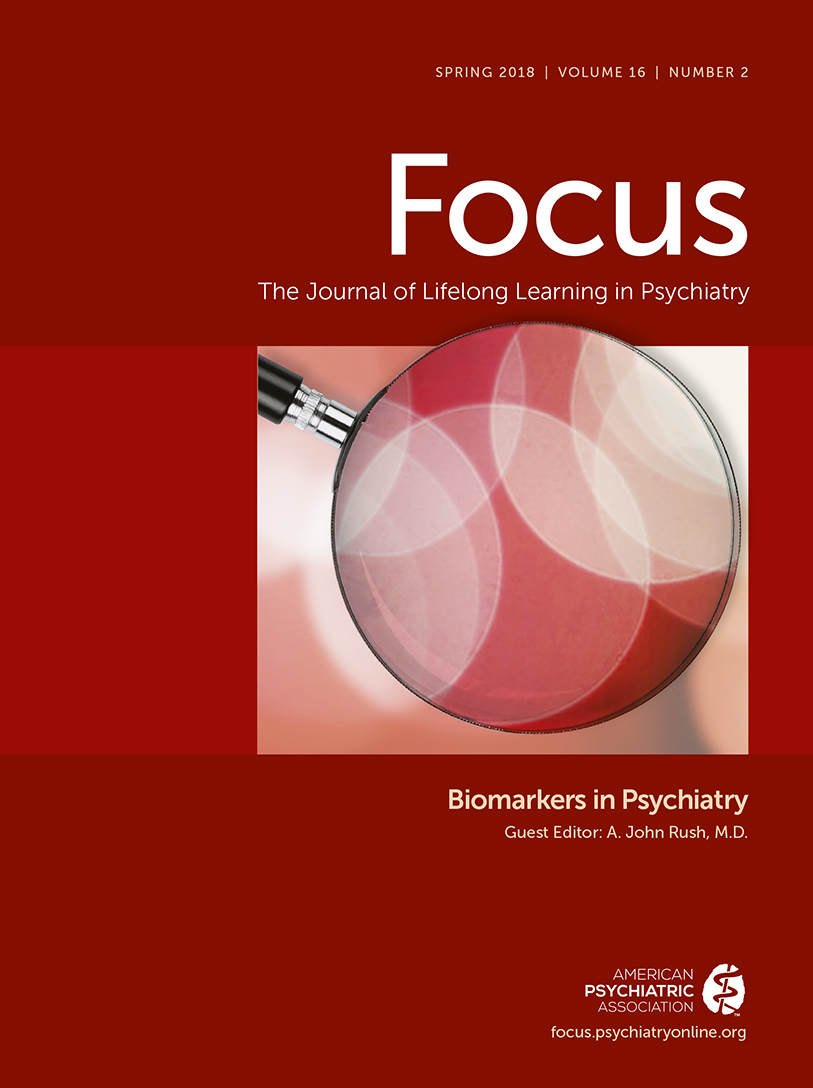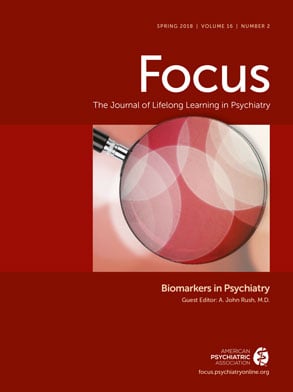Sleep that knits up the ravell’d sleave of care,
The death of each day’s life, sore labour’s bath,
Balm of hurt minds, great nature’s second course,
Chief nourisher in life’s feast.
—William Shakespeare, Macbeth, Act II, sc. 2
Case Presentation
CR is a 70-year-old white, married man, a retired civil servant. He was referred by his psychiatrist for further evaluation of sleep-maintenance insomnia over a three-year period that had not responded to sleep hygiene recommendations or use of sedative hypnotics. CR was under maintenance treatment for recurrent major depression (unipolar, nonpsychotic), taking 20 mg escitalopram daily. CR’s spouse reported that the couple had been sleeping in separate bedrooms for three months because of his loud snoring. The spouse also described episodes, lasting about 10 minutes, in which CR would get out of bed most nights, confused, and point to soldiers he believed he was seeing outside his bedroom window. He appeared to be frightened during the episodes and was difficult to reorient and console. He would get up repeatedly to watch the soldiers. On waking the next morning, he had little clear memory of the episodes. CR showed mild cognitive impairment (scoring 24 out of 30 on the Folstein Mini-Mental State Examination [MMS]) (
1) and endorsed some symptoms of depression (scoring 12 on the Quick Inventory of Depressive Symptoms: Self-Report [QIDS-SR]) (
2) and of daytime sleepiness (indicated by a score of 8 on the Epworth Sleepiness Scale) (
3). The overall quality of his sleep and waking was moderately impaired, as indicated by a score of 10 on the Pittsburgh Sleep Quality Inventory ([PSQI]; scores of ≥5 provide evidence of a sleep-wake disorder) (
4). CR reported (and his spouse endorsed) that he would have one to two beers once weekly on outings with her; he denied a history of other substance use. Physical examination showed a body mass index of 29, consistent with being overweight verging upon obesity, and mild hypertension (140/90 mmHg). Blood work showed elevation in fasting blood glucose (110) but was otherwise normal, including thyroid indices. The electrocardiogram (EKG) was normal, and waking oximetry did not show desaturation. CR reported using 20 mg escitalopram daily, prescribed by his psychiatrist, together with 100 mg losartan and 10 mg atorvastatin, prescribed by his primary care physician for high blood pressure and elevated cholesterol, respectively.
A one-night sleep study revealed frequent awakenings during the night, often following 30-s to 45-s apneas, longer during rapid eye movement sleep and accompanied by oxyhemoglobin desaturation down to levels as low as 85%. Approximately 20 apneic episodes occurred during each hour of sleep. The quality or morphology of electroencephalogram [EEG] sleep signals was degraded, characterized by an absence of normal physiologic transients (such as K-complexes and sleep spindles during stage 2 sleep). Slow-wave or delta sleep was absent, and REM sleep was reduced. At about 4 a.m., and following an apneic episode during REM sleep, CR got out of bed, appearing frightened and confused. He reported seeing soldiers outside his bedroom for about 10 minutes. When he awoke the next morning, he could not recall the episode. A multiple sleep latency test during the day showed average sleep latencies of 7–8 minutes during all five naps (consistent with mild but not pathological sleepiness) and one sleep-onset REM period ([SOREMP]; two SOREMPs would have raised the possibility of narcolepsy).
CR was treated with continuous positive airway pressure (CPAP) for moderately severe obstructive sleep apnea. Follow-up evaluation showed reduction in the number of apneic episodes per hour of sleep to under five, with improvement in the overall subjective quality of sleep (reduction in the PSQI score from 10 to 4), daytime sleepiness (reduction in the Epworth score from 8 to 4), and depression (decrease in QIDS-SR score from 12 to 8). There was also a reduction in the number of confusional episodes at night, but these continued to occur approximately twice monthly. A diagnosis of REM-sleep behavior disorder (RBD) was made; the frequency and severity of episodes decreased on treatment with pramipexole. CR’s psychiatrist maintained surveillance for depression, cognitive impairment, and sleep-wake symptoms while CR continued CPAP. Despite sustained improvement in sleep-wake symptoms, cognitive impairment slowly progressed, and about 18 months later, early signs of Parkinsonism emerged. A neurologist confirmed the presence of a movement disorder and began treatment in collaboration with CR’s psychiatrist and primary care physician.
Indications for and Utility of Sleep Evaluation in CR’s Case
CR’s history exemplified several indications for referral to a sleep medicine specialist: (
1) persistent, treatment-refractory insomnia, loud snoring accompanied by increased body mass index and hypertension, and pronounced behavioral disturbances out of sleep. The sleep evaluation (consisting of history, an interview with the spouse, daytime clinical measures, nocturnal polysomnography, and daytime nap studies) was useful for diagnosis, treatment monitoring, and indications of prognosis. It confirmed the presence of a clinically actionable breathing-related sleep disorder but also raised the question of an RBD, which is often a harbinger of alpha-synucleinopathies, such as Parkinson’s disease (PD). In addition, the degradation in the quality of the EEG sleep signal, together with the reduction in REM sleep, reinforced the suspicion of an early neurodegenerative process. The daytime nap studies did not support a diagnosis of other disorders of daytime sleepiness, such as narcolepsy. CR’s long-standing history of recurrent depression could have accounted for some of his insomnia complaints but also represented a risk factor for the onset of neurodegenerative disorders, such as Alzheimer’s disorder or vascular dementia, in the later years of life. Follow-up sleep studies allowed for confirmation that the breathing-related sleep disorder had been adequately treated; however, nocturnal confusional episodes persisted out of REM sleep, despite improvement in sleep apnea. These episodes were consistent with RBD and presaged PD and further cognitive deterioration. In addition to maintenance antidepressant pharmacotherapy, CR was treated with anti-PD medications and with a cholinesterase inhibitor (donepezil, 10 mg daily). Although use of donepezil was associated with some improvement in cognition, it also seemed to worsen CR’s depressive symptoms; switching from escitalopram to venlafaxine in doses up to 300 mg daily reduced the burden of depression while allowing the continuation of more intensive antidepressant pharmacotherapy. (It is possible that another cholinesterase inhibitor or even memantine could have been used instead of donepezil, given that they have less association with worsening depression.)
CR’s Case Study in the Context of the DSM-5
Sleep provides a window into brain and systemic health, both mental and physical. It serves restoration, repair, and information-processing functions in the brain. As such, it is profoundly relevant to the science and practice of psychiatry.
The
DSM-5 (
5) presentation of sleep-wake disorders is intended for general medical and mental health clinicians not expert in sleep-wake disorders. It discusses indications for referral, as in CR’s case, and places emphasis on measurement-based care via use of rating scales and other dimensional measures (e.g., symptomatic burden and functional status such as the PSQI and the Eppworth Sleepiness Scale), devices (e.g., actigraphy, which provides quantitative measures of the timing, regularity, and stability of sleeping and waking activity counts; and polysomnography, which provides multiple channels of physiologic data during sleep, such as breathing patterns and EKG rhythms, as well as correlation of pathophysiology with sleep-related behavioral disturbances), and biomarkers.
Box 1 summarizes the indications for referral to a sleep medicine specialist, and
Box 2 lists the sleep-wake disorders or groups of disorders encompassed by the
DSM-5. Biomarkers are relevant to the differential diagnosis of these disorders.
The DSM-5 sleep-wake disorders nosology places a strong emphasis on co-occurring disorders, or polymorbidity, which is the rule, not the exception. By specifying the co-occurrence of sleep-wake disorders and other psychiatric disorders and by recognizing the need for addressing both, the odds for optimizing health-related quality of life are improved. In essence, and as illustrated by CR’s case, sleep disturbances furnish a clinically useful indicator of medical and neurological disorders that often co-occur with depression and other common mental disorders. General medical polymorbidity embraces disorders of the musculoskeletal system, breathing-related sleep disorders, neurodegenerative disorders, and disorders of the heart and lungs. Furthermore, some of these disorders not only may disturb sleep but also may themselves be worsened during sleep, as in the case of prolonged apneas or EKG arrhythmias during REM sleep, confusional arousals of patients with dementing disorders, and RBD in alpha-synucleinopathies such as PD.
As illustrated by CR’s case, the use of biomarkers in sleep-disorder medicine serves several purposes: differential diagnosis (e.g., breathing-related sleep disorders and disorders of excessive sleepiness, such as narcolepsy, restless legs, and periodic limb movement disorder), measurement of response to treatment, and prognostic indication (in this case, presaging the development of PD). Sleep evaluation and the accompanying provision of biomarkers also provide a window into neurobiology, allowing correlation of dimensional assessment (such as severity, duration, course, waking behavior, and timing) with underlying neurobiology and pathogenesis. The use of biological validators is now embedded in the
DSM-5 classification of sleep-wake disorders (see
Box 3), particularly with respect to the differential diagnosis of excessive daytime sleepiness (narcolepsy/hypocretin deficiency), breathing-related sleep disorders (polysomnography), and restless-legs syndrome (which frequently coexists with periodic limb movement disorders).
CR’s case study illustrates the relevance of a basic knowledge of sleep-wake disorders to psychiatric practice. Sleep disturbances may be not only a symptomatic manifestation of such disorders but also a risk factor for the onset of such disorders and their sequelae, including dementia. Furthermore, sleep disturbances may represent the prodromal expression of psychiatric and neurologic disorders, thereby allowing early, pre-emptive intervention that may serve to prevent, delay, or mitigate clinical presentation. Sleep disturbance exacerbates the symptomatic and functional burden of psychiatric disorders, and residual sleep-wake symptoms presage the risk for relapse and chronicity. The co-occurrence of psychiatric disorders such as depression and sleep-wake disorders—including breathing-related sleep disorders, as in CR’s case—underscores the importance of paying attention to sleep complaints and interviewing bed partners with respect to sleep-related behavioral disturbances. Biomarkers revealed in the course of evaluation provide specific diagnostic and prognostic information, thereby informing treatment planning. As in CR’s case, treatment of co-occurring psychiatric and sleep-wake disorders is essential to ensuring optimal outcome and health-related quality of life for as long as possible (
6). Finally, CR’s case and the biomarkers that emerged from sleep evaluation underscore three other important lessons for psychiatric practice: first, the need to take a long-term perspective on illness course, treatment, and prognosis; second, the need for multidisciplinary team-based care to deal with the clinical complexity posed by co-occurring disorders; and third, the need to consider the perspectives of the caregiver, as well as that of the care recipient, both for diagnostic accuracy and for treatment adherence. In and of itself, CR’s history of recurrent depression supported the necessity of long-term medical surveillance. However, the findings from polysomnographic evaluation further bolstered the need for continuing follow-up with respect to the risk for PD.

